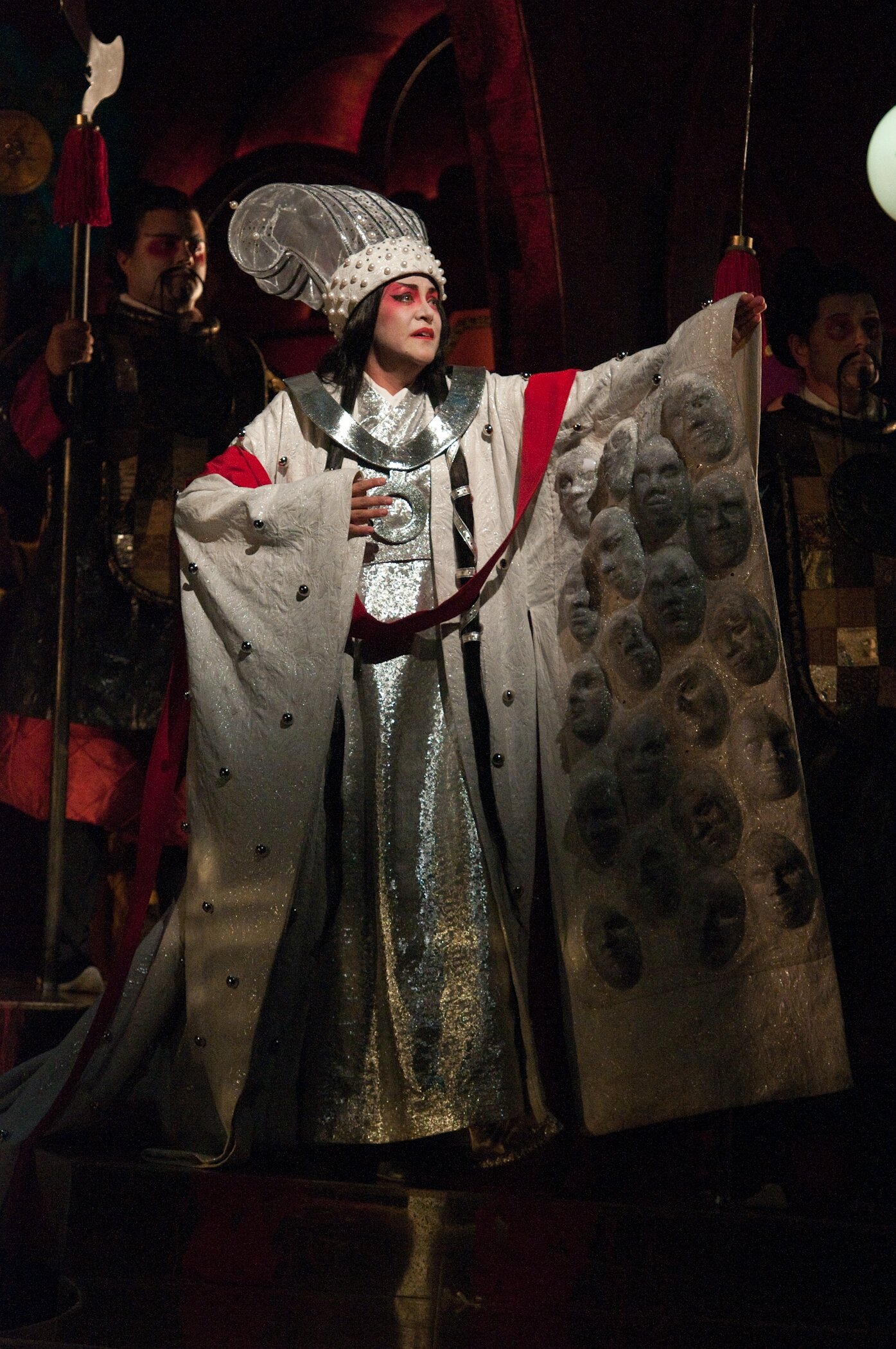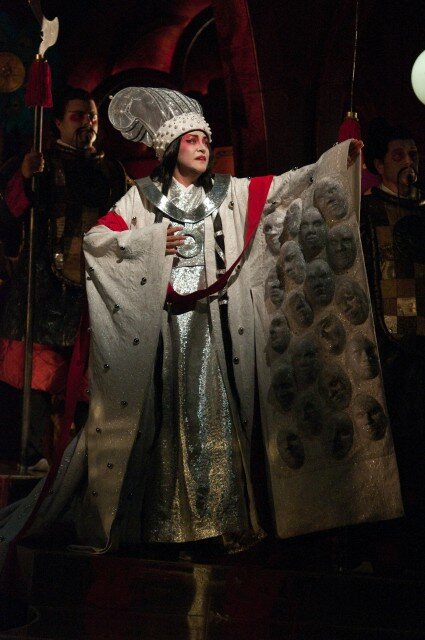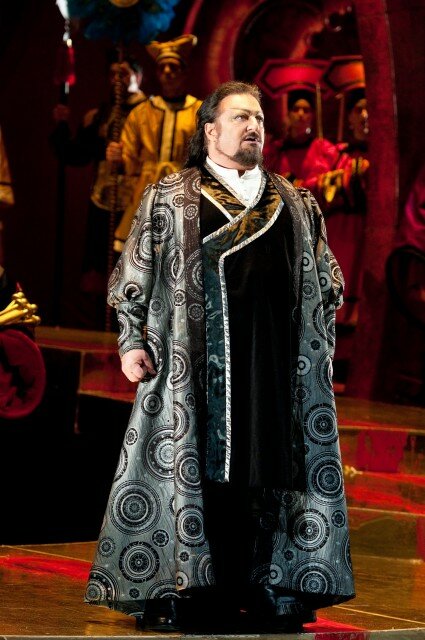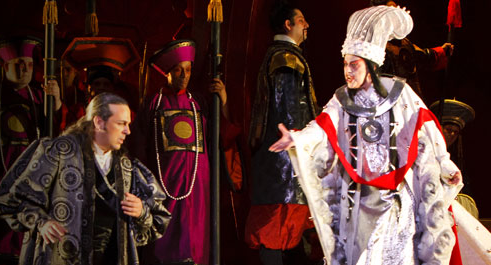Turandot, Puccini’s final opera, is grand opera in the truest sense of the words. The chorus is numerous, the roles demand large voices, and the story is epic. And Seattle Opera’s production of Turandot (through August 18 at McCaw Hall; tickets) is equally as grand and sumptuous as the music.
The titular princess, Turandot, has declared that she will only marry a man who can successfully answer three riddles, and if he cannot, he will be beheaded. Many have tried; all have died. When a mysterious prince shows up to try his luck and actually answers all three riddles correctly, Turandot is reluctant (or scared out of her mind) to honor her word.
So the prince offers a riddle himself, saying that if she can correctly guess his name by the dawn, he will agree to die. What follows are a series of sacrifices and an ending which is arguably both happy and/or regrettable.
As if he knew this opera would be his last, Puccini crams as much drama and story as he can into every moment. Instead of an overture, BOOM! we’re in Turandot’s palace, with the chorus demanding blood. Characters are introduced quickly, and connections between them are established with lightning speed (the prince sees Turandot and BOOM! he’s in love; he smiled at a slave girl years ago and BOOM! she’s in love). Arias get a measure or two of introduction and occasionally no conclusion – the music rolls ever forward, and the drama isn’t interrupted by applause.
At McCaw Hall, the sets are larger than life, and transport you to Turandot’s Peking palace immediately. For as big as they are, they never dwarf the singers. The lighting and the costuming join the sets and the staging to create a dazzling spectacle. (One article of Turandot’s costume made several audience members gasp on opening night – keep an eye out for it if you go.) The fact that everything comes together as one is due to the French-Canadian duo Renaud Doucet (stage director) and André Barbe (set and costume designer). Lighting designer Guy Simard rounds out the team.
Trappings aside, the main event with any production of Turandot is the singing. Prince Calaf (that’s his name, don’t wear it out) is a demanding spinto tenor role (“spinto” means “push” in Italian, and any spinto voice type falls in between lyric and dramatic). Liù is a classic Puccini lyric soprano role. And the main event, Turandot, is generally defined as a Wagnerian, or ultra-dramatic, soprano. (Turandot is one of the few, if not the only, Italian soprano roles classified as “Wagnerian.”)
Seattle Opera has assembled two outstanding casts in the main roles. Sharing the role of Turandot are Lori Phillips and Marcy Stonikas (a former Seattle Opera Young Artist, singing August 5 and August 12). Of the two, I preferred Stonikas by a slight margin. Her voice was warm and round from the very beginning, and the music seemed to fit her like a glove; her high notes seemed effortless. She was emotionally connected to the icy princess, making the love story slightly more believable than it might otherwise be. Phillips also has a beautiful voice, but was working fairly hard to cut through the sound of the chorus and the orchestra, and her emotional connection to the role was slightly more tenuous (alternately, more icy, which might have been a deliberate character choice).
I also preferred Grazia Doronzio as Liù (singing August 5, 8, and 12) to her opening night counterpart, Lina Tetriani. Doronzio was grounded and lyric for the duration of the role, and in glorious voice from top to bottom. Tetriani, on the other hand, had a habit of rising to her tiptoes for high notes, distracting me from the musical line and the unfolding drama.
As Calaf, Antonello Palombi and Luis Chapa (August 5 and 12) both did wonderful jobs. Chapa’s Calaf sounded a bit younger and smaller than Palombi’s, but was well sung from the very beginning. Palombi’s voice was a bit cold in the first act; some high notes lacked significant overtones. But by the second act, and for the rest of the opera, his voice was chillingly glorious. Both men did beautiful renditions of the opera’s most famous aria, “Nessun Dorma,” so anyone who goes to see Turandot just for this (and who would blame you?) will not be disappointed.
Rounding out the cast are Peter Rose as a powerful Timur, Peter Kazaras as the remote Emperor, Ashraf Sewailam as a consistent and committed Mandarin, and Patrick Carfizzi, Julius Ahn, and Joseph Hu as the opera’s comic relief, Ping, Pang and Pong (respectively). Some of the staging and costume choices for Ping, Pang, and Pong are the only aspects of the opera that pull away from the overbearing palace setting. In Act Two, the three men sing a sweet trio about all that they’ve left behind in order to be the executioner’s assistants, which becomes a vaudevillian song and dance before they’re called back to court.
A chorus this large, including both adults and children, can be hard to prepare and manage. Beth Kirchhoff has done a wonderful job with both. The large group is musically sensitive and responsive, handing phrases off beautifully both to each other and to the orchestra.
Asher Fisch led the orchestra in a passionate, precise, and powerful performance. With music like this, it would be easy for the orchestra to overpower even the strongest singers; Fisch walked the line between supportive and overpowering with sensitivity. He brought out Puccini’s orchestral colors beautifully, adding to the complete dramatic picture.










